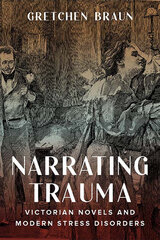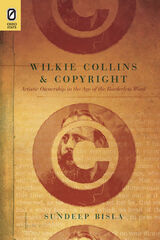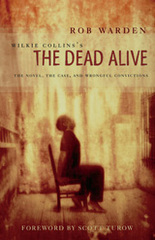4 books about Collins, Wilkie

The Moment of Racial Sight
A History
Irene Tucker
University of Chicago Press, 2012
The Moment of Racial Sight overturns the most familiar form of racial analysis in contemporary culture: the idea that race is constructed, that it operates by attaching visible marks of difference to arbitrary meanings and associations. Searching for the history of the constructed racial sign, Irene Tucker argues that if people instantly perceive racial differences despite knowing better, then the underlying function of race is to produce this immediate knowledge. Racial perception, then, is not just a mark of acculturation, but a part of how people know one another.
Tucker begins her investigation in the Enlightenment, at the moment when skin first came to be used as the primary mark of racial difference. Through Kant and his writing on the relation of philosophy and medicine, she describes how racialized skin was created as a mechanism to enable us to perceive the likeness of individuals in a moment. From there, Tucker tells the story of instantaneous racial seeing across centuries—from the fictive bodies described but not seen in Wilkie Collins’s realism to the medium of common public opinion in John Stuart Mill, from the invention of the notion of a constructed racial sign in Darwin’s late work to the institutionalizing of racial sight on display in the HBO series The Wire. Rich with perceptive readings of unexpected texts, this ambitious book is an important intervention in the study of race.
[more]

Narrating Trauma
Victorian Novels and Modern Stress Disorders
Gretchen Braun
The Ohio State University Press, 2022
Neurasthenia, rail shock, hysteria. In Narrating Trauma, Gretchen Braun traces the nineteenth-century prehistory of those mental and physical responses that we now classify as post-traumatic stress and explores their influence on the Victorian novel. Engaging dialogues between both present-day and nineteenth-century mental science and literature, Braun examines novels that show the development of the mental dysfunction known as nervous disorder, positing that it was understood not as a failure of reason but instead as an organically based, crippling disjunction between the individual mind and its social context—with sufferers inhabiting spaces between sanity and madness.
Spanning from the early Victorian period to the fin de siècle and encompassing realist, Gothic, sentimental, and sensation fiction, Narrating Trauma studies trauma across works of fiction by Charlotte Brontë, Emily Jolly, Wilkie Collins, George Eliot, Charles Dickens, and Thomas Hardy. In doing so, Braun brings both nineteenth-century science and current theories of trauma to bear on the narrative patterns that develop around mentally disordered women and men feminized by nervous disorder, creating a framework for novelistic critique of modern lifestyles, stressors, and institutions.
Spanning from the early Victorian period to the fin de siècle and encompassing realist, Gothic, sentimental, and sensation fiction, Narrating Trauma studies trauma across works of fiction by Charlotte Brontë, Emily Jolly, Wilkie Collins, George Eliot, Charles Dickens, and Thomas Hardy. In doing so, Braun brings both nineteenth-century science and current theories of trauma to bear on the narrative patterns that develop around mentally disordered women and men feminized by nervous disorder, creating a framework for novelistic critique of modern lifestyles, stressors, and institutions.
[more]

Wilkie Collins and Copyright
Sundeep Bisla
The Ohio State University Press
In the works and letters of his later years, Wilkie Collins continually expressed his displeasure over copyright violations. Wilkie Collins and Copyright: Artistic Ownership in the Age of the Borderless Word by Sundeep Bisla asks whether that discontent might not also have affected the composition of Collins’s major early works of the 1850s and 60s. Bisla’s investigation into this question, surprisingly, does not find an uncomplicated author uncomplicatedly launched on a defense of what he believes to be rightfully his. Instead, Bisla finds an author locked in fierce negotiation with the theoretical underpinnings of his medium, the written word, underpinnings best delineated by the twentieth-century deconstructionist Jacques Derrida. Collins’s discomfort with copyright violation comes to be in tension with his budding understanding of the paradoxical nature of the “iterability” of the word, a nature presenting itself as a conflict between the settling and breaking manifestations of linguistic repetition. In his efforts at resolving this paradox, Collins adopts a mechanism of recursive self-reflexivity through which each story reflects upon itself to a more fundamental extent than had its predecessor. This self-reflexive exploration has significant consequences for the author’s own iterability-menaced subjectivity, a striking example of which can be seen in the fact that the name being sought in Collins’s last masterpiece, The Moonstone, will end up being “MY OWN NAME” — in other words, “WILKIE COLLINS.”
[more]

Wilkie Collins's The Dead Alive
The Novel, the Case, and Wrongful Convictions
Wilkie Collins
Northwestern University Press, 2005
On the evidence of The Dead Alive, Scott Turow writes in his foreword that Wilkie Collins might well be the first author of a legal thriller. Here is the lawyer out of sorts with his profession; the legal process gone awry; even a touch of romance to soften the rigors of the law. And here, too, recast as fiction, is the United States' first documented wrongful conviction case. Side by side with the novel, this book presents the real-life legal thriller Collins used as his model-the story of two brothers, Jesse and Stephen Boorn, sentenced to death in Vermont in 1819 for the murder of their brother-in-law, and belatedly exonerated when their "victim" showed up alive and well in New Jersey in 1820.
Rob Warden, one of the nation's most eloquent and effective advocates for the wrongly convicted, reconsiders the facts of the Boorn case for what they can tell us about the systemic flaws that produced this first known miscarriage of justice-flaws that continue to riddle our system of justice today. A tale of false confessions and jailhouse snitches, of evidence overlooked, and justice more blinkered than blind, the Boorns' story reminds us of the perennial nature of the errors at the heart of American jurisprudence-and of the need to question and correct a system that regularly condemns the innocent.
Rob Warden, one of the nation's most eloquent and effective advocates for the wrongly convicted, reconsiders the facts of the Boorn case for what they can tell us about the systemic flaws that produced this first known miscarriage of justice-flaws that continue to riddle our system of justice today. A tale of false confessions and jailhouse snitches, of evidence overlooked, and justice more blinkered than blind, the Boorns' story reminds us of the perennial nature of the errors at the heart of American jurisprudence-and of the need to question and correct a system that regularly condemns the innocent.
[more]
READERS
Browse our collection.
PUBLISHERS
See BiblioVault's publisher services.
STUDENT SERVICES
Files for college accessibility offices.
UChicago Accessibility Resources
home | accessibility | search | about | contact us
BiblioVault ® 2001 - 2024
The University of Chicago Press









